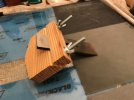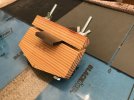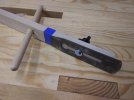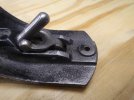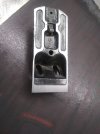As I have "discovered" scrub planes and turns out it is one of my most useful tools, I now need to prefect sharpening them. Being a roughout tool, they take a bit if a beating.
OK, I seem to do pretty well grinding just pivoting around my thumb through the slot. Not that great on honing. I thought about using the old Eclipse jig but it can't rock far enough.
FWIW, I have been primary grinding @ 30, 3 1/2" radius. They seem to hog out stock pretty well at only 1200 hone but upping it a bit when my new plates get here. Not sure it matters as a few swipes and they are probably back to 1200 or so.
I have an idea for a way to pivot around a peg in the grinder stage so that will make it easier, but the honing is still a question. Anyone made a clever jig? Thinking about a stick that mounts through the slot to a height reference stick back behind the stone.
On a side note, I have been learning the hard way about the difference in flatness of a stone vs diamond plate. Just the tiniest dish, one or two strokes, is enough to back bevel a couple mm, so flattening back to dead level is quite a chore. Leather strops and even the give in paper for Scary seem to be enough to cause me a headache. ( arm ache) Can't really use the ruler trick on a scrub plane.
OK, I seem to do pretty well grinding just pivoting around my thumb through the slot. Not that great on honing. I thought about using the old Eclipse jig but it can't rock far enough.
FWIW, I have been primary grinding @ 30, 3 1/2" radius. They seem to hog out stock pretty well at only 1200 hone but upping it a bit when my new plates get here. Not sure it matters as a few swipes and they are probably back to 1200 or so.
I have an idea for a way to pivot around a peg in the grinder stage so that will make it easier, but the honing is still a question. Anyone made a clever jig? Thinking about a stick that mounts through the slot to a height reference stick back behind the stone.
On a side note, I have been learning the hard way about the difference in flatness of a stone vs diamond plate. Just the tiniest dish, one or two strokes, is enough to back bevel a couple mm, so flattening back to dead level is quite a chore. Leather strops and even the give in paper for Scary seem to be enough to cause me a headache. ( arm ache) Can't really use the ruler trick on a scrub plane.

